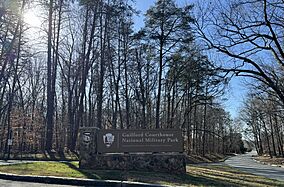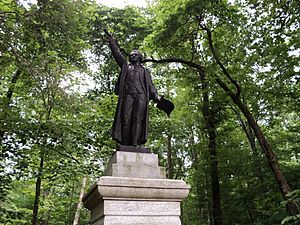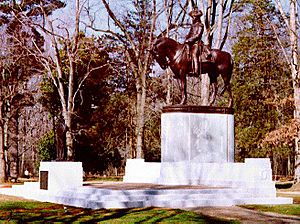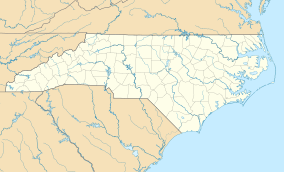Guilford Courthouse National Military Park facts for kids
Quick facts for kids Guilford Courthouse National Military Park |
|
|---|---|
|
IUCN Category III (Natural Monument)
|
|

Entrance to the park.
|
|
| Location | Greensboro, North Carolina, USA |
| Nearest city | Greensboro, NC |
| Area | 253.54 acres (102.60 ha) |
| Established | March 2, 1917 |
| Visitors | 277,484 (in 2004) |
| Governing body | National Park Service |
| Website | Guilford Courthouse National Military Park |
|
Guilford Courthouse National Military Park
|
|
| Nearest city | Greensboro, North Carolina |
| Architect | National Park Service; Bureau of Public Roads |
| Architectural style | Colonial Revival |
| NRHP reference No. | 66000069 |
| Significant dates | |
| Added to NRHP | October 15, 1966 |
| Designated NHLD | January 3, 2001 |
Guilford Courthouse National Military Park is a special place in Greensboro, North Carolina. It remembers the important Battle of Guilford Court House. This battle happened on March 15, 1781, during the American Revolutionary War.
Even though the British army won this battle, they lost many soldiers. These losses helped lead to their surrender at Yorktown just seven months later. This surrender was a big step towards America winning its independence. The National Park Service (NPS) now takes care of this historic battlefield.
Contents
Remembering the Battle: Guilford Courthouse Park
How the Park Began
In 1886, a local person named David Schenck wanted to save the battlefield. He started a group called the Guilford Battle Ground Company (GBGC). Their goal was to buy the land and turn it into a park.
Mr. Schenck planned to give this land to the United States government. In 1917, the U.S. Congress officially made Guilford Courthouse a national military park. The GBGC then gave over 125 acres of land for free. Without David Schenck's hard work, this park might not exist today.
Early Ideas and Mistakes
The GBGC did a lot to start the park, but some things were not quite right. David Schenck wanted the park to look nice, so he changed the landscape. He didn't keep it exactly as it was during the battle.
Also, many monuments were put up by historical groups. These monuments were meant to honor the soldiers. However, they were often placed in convenient spots, not always where the actual fighting happened. This was because they weren't based on careful historical research.
Discovering the Real Battlefield
David Schenck also believed the battle covered a smaller area than it actually did. Historians think he might have had limited money to buy land. This led to monuments and markers being placed in the wrong locations.
It also made it harder for the government to protect the true battlefield. Over time, the city of Greensboro grew around the park. This growth sometimes damaged parts of the real battleground.
New Research, Better Understanding
Today, the National Park Service has done more research. They now have a much better understanding of where the battle truly happened. This new information shows that many old monuments are not in their correct historical spots.
The park hopes to rebuild parts of the battlefield to match the historical evidence. The Guilford Battleground Company still helps protect the park. They also support the Colonial Heritage Center, where British forces gathered before the battle.
The park is a great place for exercise too! It connects to Greensboro Country Park with a bike path. Many people enjoy jogging and cycling there.


The Park's Official Journey
Guilford Courthouse National Military Park officially opened on March 2, 1917. It was first managed by the War Department. Then, on August 10, 1933, it became part of the National Park Service.
In 1966, the park was listed on the National Register of Historic Places. This means it's recognized as an important historical site. In 2001, it received an even higher honor, becoming a National Historic Landmark.
See also
- Battle of Guilford Court House
- Guilford Court House, North Carolina
- Hoskins House Historic District
- List of National Historic Landmarks in North Carolina
- National Register of Historic Places listings in Guilford County, North Carolina






